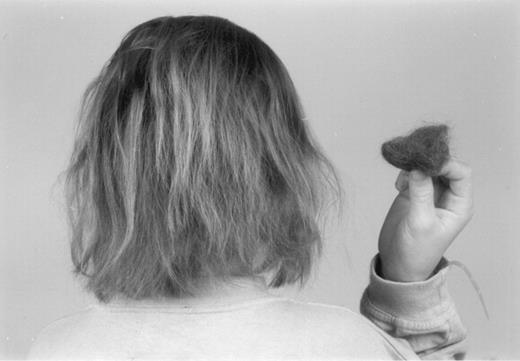Alopecia has not been reported as a side effect of dalteparin. We report the case of a 9-year-old girl who was treated with dalteparin sodium (Pharmacia and Upjohn, Rydalmere, Australia) for sinus venous thrombosis and experienced alopecia that improved on withdrawal of the drug.
The patient presented with headache, neck stiffness, and photophobia in the setting of bilateral otorrhea. Examination showed an unwell girl with an obvious right-sided VIth nerve palsy. Fundoscopy showed blurring of optic disc margins bilaterally. The patient was commenced on IV antibiotics and a performed CT scan demonstrated extensive erosion of the right middle ear and mastoid process associated with right transverse/sigmoid sinus thrombosis. A lumbar puncture showed a cerebrospinal fluid (CSF) opening pressure of greater than 35cm H2O. No bacterium was isolated on routine culture. The patient had a right-sided cortical mastoidectomy, open removal of thrombus from the sigmoid sinus, and drainage of a perisinus abscess. An ultrasound of the neck showed a complete occlusion of the right internal jugular vein, with thrombus extending to the junction of internal jugular and subclavian veins. The patient was commenced on dalteparin at 100 U/kg given subcutaneously twice daily and monitored with weekly anti-Xa assays. Coumarin was not considered for our patient because of the need for regular therapeutic lumbar punctures. Dalteparin was ceased 24 hours before each lumbar puncture and recommenced 12 hours later. The medications to which the patient was exposed during her inpatient stay included third-generation cephalosporins, natural and synthetic penicillins, aminogylcosides, metoclopromide, paracetamol, and ibuprofen. The patient tolerated further definitive ENT (ear, nose, and throat) surgery without complication. Six weeks after presentation, the patient's eye movements had returned to normal, and audiology showed a moderate conductive hearing loss.
Ten weeks after starting dalteparin, the patient experienced rapid extensive hair loss (see Figure). Examination showed patchy areas of nonscarring alopecia among areas of normal hair growth. The hairs shed were normal in appearance. The patient had been completely well for one month and, apart from dalteparin, had not had any medication for approximately 3 weeks. A repeat ultrasound failed to demonstrate any blood flow within the right jugular vein. In the setting of an improved clinical state and with the onset of alopecia, the dalteparin was ceased. The hair loss improved over the next 2 weeks.
Sinus venous thrombosis in children is an infrequent complication of otitis media and mastoiditis and has been the subject of 2 recent reviews.1, 2 Randomised controlled trials in adult patients have shown an improved neurological outcome with anticoagulation.3,4 A 1999 analysis by de Veber of 150 childhood cases of sinus venous thrombosis showed a decrease in neurological morbidity in the 14 patients treated with anticoagulation.5 The optimal type and duration of anticoagulation in children with sinus venous thrombosis is unknown.6
The prolonged use of low-molecular-weight heparin in our patient had advantages of a minimal need for monitoring and ease of withdrawal of anticoagulation when required for repeated therapeutic lumbar punctures. The side-effect profile of the low-molecular-weight heparin dalteparin is similar to unfractionated heparin, but until this report, alopecia has apparently not been reported (personal correspondence from Pharmacia Upjohn and extensive search of literature). Unfractionated heparin and all other anticoagulants are known to cause alopecia, but the mechanism of hair loss is unknown.7 8
Drug-induced alopecia results from either an abrupt cessation of the normal growth phase (anagen effluvium) or a premature transformation of growing hairs into the resting phase (telogen effluvium).7Anagen effluvium results in rapid loss of dystrophic hairs and is commonly seen during treatment with chemotherapy. Telogen effluvium, however, leads to hairs being shed 6 weeks to 3 months after drug exposure. Because hair loss is delayed, the alopecia may be difficult to assign to a certain drug exposure. Our patient received 5 doses of oral ibuprofen and intravenous gentamicin, both of which have been associated with alopecia.8 But based on the well-established association of alopecia and anticoagulants and the timing of the hair loss, we believe dalteparin was the causative agent for hair loss in our patient.


This feature is available to Subscribers Only
Sign In or Create an Account Close Modal